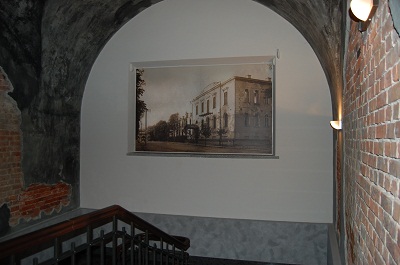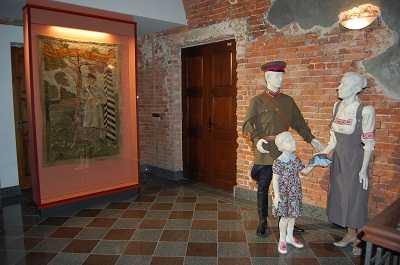The 2nd floor area
With the beginning of the 40s year of the former century, the main part of fortress buildings, including the casern, was preserved from the 19th century. It happened in spite of the war events from 1914 – 1915, 1918 – 1920 and 1939 years. The pictures on the window between the 1st and the 2nd floors show the prewar fortress. On the foreground on the right, there is an engineering department, which was destroyed in June 1941. The ruins of this building are lying next to the Eternal Flame. On the background to the left there are three-arch gates that have been dismantled in the end of 40s years of the 20th century.

On the eve of the Great Patriotic War, the Brest Fortress remained a military town with a regular garrison and a housing of the commanding crew families. The land and antitank artillery guns, automotive and armored cars were placed in the fields on the open air.

On the 2nd flood area there are three mannequins, displaying the image of the Red Army commanding officer family: father – infantry lieutenant, his wife and 6 year old daughter. The soldier is dressed with a Red Army commanding officer uniform, his wife has a sarafan and a blouse with national Belarusian ornament, the girl is dressed with a summer dress and shoes. Their clothing come from the 40s years from the 20th century. Starting from the 28th of September 1939, according to the Treaty of Friendship and a border between the Soviet Union and Germany, the new state border was formed along the Western Bug river and the bypass Brest Fortress channel behind the Terespol fortification. The frontier-guards from the 17th Red Army border detachment have been protecting the new ground. The border line situation of the Brest Fortress in the beginning of the war is showcased on the carpet called “The Soviet Frontier-Guard”. It is a handwork made by the wives of the Unech military officers timed to the 23rd anniversary of the Red Army creation (23rd of February, 1941). This carpet was left at the Brest resident P. Galash by the unknown Red Army commander. The fate of the commander is unknown, and the carped was handed by P. Galash to the Brest Fortress defense museum in 1969. The main exposition is located on the 2nd floor, divided by 8 halls:
Hall 1 – “On the Eve”,
Hall 2 – “Battle”,
Halls 3 - 4 – “Challenge”,
Hall 5 – “Recognition”,
Hall 6 – “The Echo of War”,
Hall 7 – “Heritage”,
Hall 8 – “The roads of memory”
